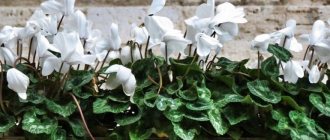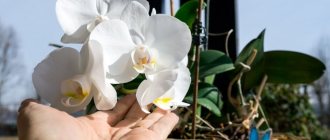Monstera is a spectacular exotic plant that is often grown in an apartment or office. The culture is valued for its unpretentious nature, fast growth and beautiful carved leaves. In its natural environment, it blooms annually, and after large buds it even produces edible fruits. But in an apartment or office, achieving this from a plant is not so easy. Whether monstera blooms at home and what needs to be done for this will be discussed below.
A little history
Monstera is a member of the Araceae family. In its natural environment, the culture can be found in the tropical forests of Central and South America. Here the plant reaches 40–50 meters in length. But at home its size is much more modest.
The flower got its name for its enormous size and bizarre shape (from monstrum - “monster”, “monster”, monstrous - “amazing”). A few centuries ago, it was believed that this plant was dangerous and capable of strangling other trees, even animals and people, with its shoots. And the discoverers mistook its aerial roots for predatory tentacles. In addition, the shoots often grew through the skeletons of those killed in the jungle. And the helpful imagination of travelers completed the gloomy pictures. Therefore, the plant was given the title of “killer”; many were afraid to grow it at home.
But even now the monstera is singled out among others and magical properties are attributed to it. For example, it was from a vine bud that Amanita Nightshade appeared in the popular animated series “Monster High: Blooming Twilight.”
Description. Benefit and harm to humans
Monstera (Monstera) is a very large plant in the form of an evergreen vine. The study of Monstera is still ongoing and is currently classified as a member of the Aroid family (Araceae).
Monstera leaves are green, perforated and dissected, half a meter long. The juice of the leaves is poisonous and, if it comes into contact with the mucous membrane, causes various reactions: swelling, inflammation, loss of voice, intestinal disorders, dysphagia (swallowing disorder) and numbness.
Indoor monsteras grow up to several meters in length, growing into huge thickets of vines. They crawl along supports using aerial (adventitious) roots. An interesting fact is that if the monstera loses contact with the ground, it will not die, but will live fully on other plants (epiphyte).
Monstera flowers and bears fruit in the form of berries.
Despite its horrific past, the modern house monstera is valued not only for its exotic appearance, but also for its beneficial qualities. During the daytime, monstera leaves release a large amount of oxygen and make the indoor air more humid. They absorb formaldehyde vapors and electromagnetic radiation, ionize the air and evaporate excess moisture.
But at night, the process of photosynthesis completely stops and the plant begins to absorb oxygen in huge volumes. It is for this reason that it is not recommended for children's rooms and bedrooms.
Monstera continues to be ascribed supernatural, but now positive, properties. It is believed that it has a positive effect on the nervous and immune systems, develops intelligence and intuition, and increases performance. This reputation has made the monstera an inhabitant of office premises, classrooms and educational institutions. Psychologists and esotericists love this plant.
Botanical description
The evergreen vine has a thick stem and many aerial roots with which it clings to supports and trees. In addition, some appendages sink into the soil and receive additional nutrition from it. The main feature of the flower is its large carved leaves, reaching up to 50 cm in diameter. Moreover, young plates are solid, but as they grow, bizarre slits appear on them. And the larger the leaves, the more holes they have.
Monstera is a flowering plant. In its natural environment, buds appear annually on it, resembling an ear of corn wrapped in a blanket. A photo of a blooming monstera is given in the material. After the buds, a fruit is formed - a berry up to 20 cm long. It is edible and tastes like something between a banana and pineapple.
In some countries, the crop is bred precisely for its sweet fruits. But achieving a harvest at home is not easy. Only experienced flower growers will be able to see how the monstera blooms and get its fruits, who will create optimal conditions for the tropical beauty.
Interesting facts about Monstera deliciosa
There are many myths about the plant. The most common rumors are that monstera is poisonous, brings trouble to the house and takes away energy from the residents. There is no scientific confirmation of this, so you can safely start a vine in your apartment.
Monstera flower - what the plant and leaf look like
What interesting things are known about Monstera Deliciosa:
- from Latin the name “monstrum” is translated as “monster”. It occurred thanks to creeping stems, the diameter of which reaches 20 cm and has long aerial roots;
- according to another version from Latin, the name is translated as “bizarre”, “amazing”, which fully corresponds to its appearance;
- Princess of Brazil Isabella of Braganza, daughter of Emperor Pedro II, started the tradition of eating monstera fruits for dessert; it was her favorite delicacy;
- before the rain, drops of sticky juice appear on the leaves, so the flower is a kind of barometer;
- Esotericists believe that aerial roots take away energy from those around them, but they are necessary solely to obtain additional moisture from the air, since the plant’s homeland is the tropics;
- residents of Southeast Asia are confident that monstera is a source of health and well-being;
- in Thailand, it is customary to place a pot of vines near sick people;
- In Laos, Monstera deliciosa is used as a talisman and placed on the doorstep of the house.
Note! There are also several versions about the origin of the name of the flower, which concern not only its appearance. One of the legends says that after the discovery of South America, killer plants were discovered in the jungle that attacked people and animals. They said that after the battle with the vines, all that remained of the body were skeletons hanging from the trunk. In fact, travelers confused the murders with aerial roots sprouted into the already deceased body of a person who once died in the jungle.
Liana in the wild
Rules for caring for crops
Monstera is an unpretentious plant and is easy to care for. It is enough to provide the crop with regular watering, fertilizing and spraying so that it takes root and begins to grow rapidly.
But if you want to see the buds of the plant, you will have to make a lot of effort. After all, monstera blooms at home only if you create a comfortable habitat close to natural. And for this you will need to plant the plant in suitable soil and pot, place the crop in a place with certain lighting and do not forget about regular feeding and watering. It is also important to provide the flower with maximum free space. Therefore, it should be placed in really spacious rooms. Then the exotic guest will delight you with large buds and edible fruits. But keep in mind that you will have to wait 7–8 years for them. A photo of how monstera blooms at home is given below.
Dormancy and flowering period
Monstera is an evergreen plant without a pronounced dormant period. When daylight hours decrease and the ambient temperature drops below +20 °C, it slows down its growth. In addition, in winter it does not require fertilizers; watering becomes more scarce. This period gives the vine a break and the opportunity to begin to develop quickly again in the spring.
In nature, the plant blooms with large, up to 30 cm tall, white or light cream flowers, reminiscent of corn cobs. Unfortunately, this practically does not happen at home. Only sometimes can flowering and fruiting be achieved in large greenhouses or winter gardens.
About 8–10 months after flowering, Monstera fruits are fully ripened. Its berries are edible, as reflected in the name - monstera deliciosa or tasty.
Temperature
In order for the monstera to bloom, maintain the room temperature from spring to autumn within +22...+25 °C. In winter, the plant tolerates a drop to +16 °C, but it should not be brought to this level. In cooler conditions, the growth and development of the flower slows down, and buds do not appear on it.
To make the monstera feel comfortable, protect it from drafts and cold air coming from the air conditioner. In addition, it is not advisable to place a pot with a plant near radiators and heating appliances.
Monstera reproduction
Seeds
This is a fairly long method, from which insignificant results can be seen 2 years after sowing.
The seeds are planted in the usual monstera soil mixture and kept in a warm and well-lit place. Within a month, the seeds germinate. There is no need to replant the seedlings; they will take root and grow slowly over several years. The usual procedure of transplanting into a larger pot is carried out when 8-10 leaves appear on the vine.
Cuttings
This method is usually used after annual pruning. After the top is removed from the vine, it can not be thrown away, but divided into cuttings. Place them in water or wet river sand. As soon as the cuttings take root, the vine is placed in a pot of soil and then grows as an adult plant with appropriate care.
Air layering
Basically, monsteras use the “aerial shoots” method for propagation. This is the simplest option, which immediately produces a small but completely independent vine. This layering is a finished stem with foliage and an aerial root, which is cut off as a whole part and immediately placed in the ground.
Helpful advice! Regardless of the method of reproduction, the monstera is extremely vulnerable during rooting. To prevent young roots from rotting, you need to add crushed activated carbon to the water for irrigation and maintain the air temperature at 20-25 degrees.
Support, space, container
Even the home decorative monstera, depending on the variety, can grow up to five meters. Accordingly, its root system is very massive and it needs a lot of space. Therefore, the room for keeping such a plant should be spacious and the container voluminous. At the same time, the vine loves peace, so the place should be stationary so that the monster does not have to be moved.
To grow and develop, the vine needs support, which it will weave around. Such structures can be created from bamboo sticks. But to make caring for the monstera easier in terms of watering the aerial roots, you can build supports from plastic or metal mesh, inside of which you can place moss, peat or any natural component that retains moisture well.
Thus, watering can be carried out through this support, ensuring a uniform flow of water to the aerial roots and the main root system.
Lighting
Do you want to see a blooming monstera at home? Then provide the exotic beauty with optimal lighting. The plant prefers bright, but diffused light, without direct sunlight. The east or west side of the room will do. If you grow monstera near a south window, hang tulle or gauze over the flower during the midday hours.
But in the north, the tropical guest will suffer from lack of light. It, of course, will not die, but here the culture will stop developing and will never bloom. In addition, carved holes are unlikely to appear on its leaves.
Monstera: poisonous or not
Since the plant came to Europe from the tropics, the logical question is whether it is possible to put a flower at home, whether Monstera is poisonous or not, especially if there are small children or pets in the room.
Is it possible to keep Monstera deliciosa at home?
Monstera variegated or variegated in the interior
Keeping a plant in the house is not only possible, but also necessary. Monstera leaves do not contain any hazardous substances. You should be careful with microscopic needle-like formations that are in the pulp of the leaves, which can cause a burning sensation if the leaf gets into the mouth. This can happen to cats, dogs or parrots who sin to nibble indoor flowers.
Note! It is believed that tropical plants absorb large amounts of oxygen, especially at night, which can cause suffocation in a sleeping person. No such case has been recorded.
As for the toxicity of the plant, there is some truth in this statement. There is poison in the juice of plant flowers, but in order to burn the mucous membranes of the mouth and stomach, you need to bite and chew the flower petal.
In defense of the monstera, it is worth noting that its leaves are good at trapping dust that enters the room. At the same time, the plant releases biologically active substances that purify the air and fight certain viruses and bacteria.
Watering and humidity
Monstera is a tropical and moisture-loving plant. And in the summer it needs abundant and regular watering. It is advisable to keep the soil moist, but not wet, because stagnation of water in the soil causes the roots to rot and unattractive spots to appear on the leaves. In winter, if you keep the flower in a cool room, water the soil moderately.
You can tell that you have overdone the irrigation by the droplets of liquid that form on the edges of the plates. If you notice this phenomenon, then reduce soil moisture to avoid root rot.
For irrigation, use only settled, soft water at room temperature. And it is also important to filter the liquid so that it does not contain lime impurities. Water the flower in the morning or evening. When irrigated at noon or at night, the leaves of the flower will begin to dry out.
The monstera flower blooms if you provide additional spraying of the leaves. It is especially important to carry out this activity in the heat, when large leaves of the crop actively evaporate moisture. In winter, in cool conditions, it is enough to limit yourself to hygienic cleaning of leaves from dust.
How to care for monstera at home
The plant is undemanding to temperature and lighting, which allows it to be grown in different parts of the house. It tolerates temperature changes, dryness and air pollution well, and can withstand lack of watering for some time. At the same time, the vine continues to grow, but stops blooming and bearing fruit.
Where to put it in the apartment
The flower is sensitive to movement. It is better to immediately determine the final place for it and not move it unnecessarily in the future. In deep shade, the monstera can die, and the open sun can leave burns on the leaves.
Illumination
The plant loves bright but diffused lighting with light shading. It is important to create conditions that are optimally close to nature in order to preserve the bright color of the leaves. Lack of light leads to a decrease in the size of the leaf plate and diseases of the aerial roots, which has a detrimental effect on the condition of the entire flower.
Temperature
Monstera feels comfortable in a wide range of temperatures: from 16 to 25 degrees. In cool conditions, its growth slows down, and in warm conditions it becomes more intense. In spring and summer, the optimal temperature is from 20 to 25 degrees, in late autumn and winter - 16–18 degrees. Drafts should be avoided. The room thermometer in a room with Monstera should not fall below 10 degrees.
Watering
The intensity of watering depends on the time of year. In spring and summer, the soil should be moistened abundantly immediately after the top layer has dried. In winter, the frequency of watering is reduced, waiting 1–2 days after the substrate dries.
The flower reacts negatively to both drying out of the soil mixture and stagnation of moisture. Overwatering can cause rot on the roots and spots on the leaf blades.
To water the monstera, soft, settled water is used.
Spraying
The plant really loves the procedure of spraying the leaves with a spray bottle. It is advisable to do this once every 1-2 weeks with well-settled water at room temperature. As monstera leaves become dirty, they should be cleaned of dust using a soft, damp cloth.
Fertilizer
The plant develops well even without additional nutrition. However, feeding will only benefit him. Organic and mineral fertilizers are alternated, using once every 2-3 weeks from the second half of spring until the beginning of autumn.
Trimming
After the active growth of the vine slows down, it is recommended to periodically cut off the top to stimulate the development of side shoots.
Bloom
In nature, Monstera blooms annually, but flowering in an apartment is not easy to achieve. With good care and timely application of fertilizers, a couple of years after planting, Monstera can form an inflorescence of small flowers in the shape of a cob, covered with a white blanket with a cream or yellowish tint. Subsequently, a fruit is formed in place of the cob.
Virulence
The juice of the plant is poisonous: it can cause irritation of the skin and inflammation of the mucous membranes. Unripe fruits are especially dangerous - their consumption can lead to gastric and intestinal bleeding, burns of the oral mucosa.
What to do with aerial roots
Aerial roots do not look very aesthetically pleasing, but are necessary for additional nutrition of the plant. They are usually tied to the trunk and covered with moss on top, which must be moistened with each watering.
Monstera in winter
In winter, it is advisable to give the flower a rest. If possible, the temperature in the room where the monstera grows should be reduced to 16–18 degrees, while avoiding drafts, to which the plant is very sensitive. Watering is reduced to 1-2 times a week (a couple of days after the top layer of soil dries). There is no need to feed the vine in winter.
How to make a flower bloom
Outside of nature, Monstera rarely blooms. To achieve this, create conditions as close as possible to the tropical climate:
- bright but diffused light with slight shading;
- abundant watering and spraying;
- air temperature from 20 to 25 degrees;
- a pot of suitable size in depth and width, correctly selected soil;
- preservation of aerial roots.
If all conditions are met, you can expect the inflorescence to appear 2-3 years after planting.
Transfer
Replant young plants every spring. When the flower reaches 4 years of age, carry out a similar event every 3-4 years. Replant adult specimens no more than once every five years, but change the top layer of soil (2.5 cm) annually. Carry out the procedure using the transshipment method:
- Water the soil 3-4 hours before transplanting. This makes it easier to remove the plant from the pot.
- Place a drainage layer of broken brick, expanded clay or pebbles at the bottom of the container. Cover it with a small layer of soil.
- Carefully remove the flower from the pot, being careful not to damage the regular and aerial roots.
- Transplant the crop into a new container along with a lump of earth.
- Fill the voids with soil, lightly tap the sides of the pot to compact the substrate.
- Water the soil and place the flower in its usual place.
You will learn about which monstera needs a pot and substrate in the following chapters.
Monstera. Do you know the taste of this delicacy?
I first saw this plant with a “monstrous” name back in 1979 - in a book about indoor plants that was given to me.
The photo amazed me - never before had I seen a plant with such intricate and at the same time graceful leaves (at that time my knowledge did not extend beyond geraniums and cacti)...
But the description of this plant simply shocked me!
Among other things, just imagine - its edible inflorescences look like a banana and a pineapple at the same time!!!
In a word, I started dreaming about this plant... And lo and behold! A couple of years later, while walking along the central avenue of my Ural city, I saw the coveted plant in the window of the city children's library... After several visits to kind librarians, I managed to persuade one of them to take a cutting.
The cutting, placed in a jar of water, quite successfully produced roots. And since then, Monstera deliciosa has settled with me. She went through many moves, but two of them were particularly extreme.
The first extreme move took place in early October 1983. By that time, I had already gotten married, and my husband and I, having received our diplomas, went to the Far North. Our things (including some furniture, indoor plants (sansevieria, hoya, arrowroot, dieffenbachia... I didn’t have Crassula at that time) and two bags of potatoes were sent by container by rail
When we arrived in the glorious city of Lesosibirsk, there was snow there... Accordingly, one can imagine in what condition our “things” arrived a week later... When the plants and potatoes began to thaw, there were a lot of tears and... a bad smell (since we hoped to save at least some potatoes, they didn’t throw them away right away...). Surprisingly, it turned out that only the above-ground part of the plants died - the roots survived and gave me new shoots!
I prepared the second extreme journey (now to Novosibirsk) for our plants thoroughly, taught by a long-standing sad experience; before loading them into the container, I cut them all “down to the stump”... As a result, they arrived safely - gradually they all gave new shoots and took on a quite decent appearance. You have already seen my magnificent monstera in the first photo
Description of the plant
Monstera is a large evergreen tropical vine of the araceae family.
Homeland - South America. In our country it is grown as an ornamental foliage plant. Adult specimens have a curved, thick, woody stem. It has large (at home up to 30 cm in length) leathery leaves of a rich green color - each fan-shaped dissected leaf is unique in its shape
But the first leaf on each new shoot does not have cuts - but its shape resembles a heart. The reverse side of the leaf, matte and lighter, has small dark and very graphic veins
Numerous aerial roots give the plant uniqueness and a special exotic charm - you can help them grow to the ground - this will not only decorate it, but also give the plant additional nutrition
Monstera leaves are very poisonous - chewing them by a person or animal can cause poisoning. Typical symptoms of this poisoning are numbness and irritation of the mouth and throat, painful swelling, and loss of voice.
But this vine has edible inflorescences! Under favorable conditions, Monstera is able to give its owners unique “fruits”, for which this plant is grown in tropical countries. [My monstera still hasn’t made me happy with either the taste of banana or the smell of pineapple. Do you know the taste of this delicacy?]
Growing conditions
Monstera prefers moderation in everything:
- loves moderate lighting - place it on an eastern or western window (in direct sun it can get burned, and on a northern window the leaves will become smaller and lose their cutness),
- loves moderate watering - do not overfill it with water or overdry it,
- loves moderate heat - at a temperature of +20...+25°C she feels great,
- loves moist air - like any tropical plant, in summer at temperatures above +26°C the vine responds well to frequent spraying with clean, settled water,
- loves neutral soil.
Planting and transplanting
A large vine requires a large, stable pot and support.
But when planting a small cutting, choose a small pot. Drainage is required - it can be expanded clay, gravel, small crushed stone or foam chips. You need neutral soil with approximately the following composition: turf soil, leaf soil, peat, humus and sand in a ratio of 3:1:1:1:1. You can buy a special soil for aroid plants or a universal flower soil. Replanting - when the roots grow - by transshipment. Until the age of 4, the monstera is replanted annually - each new pot is 3-4 cm larger than the previous one. Then replanting is required much less frequently - once every 3-4 years, but it is recommended to replace (renew) the top layer of soil. [Although personally, I don’t really understand how to do this, taking into account the attached aerial roots... I mulched the surface of the soil with small crushed stone... Do you like it? I do not like? ]
Reproduction
Monstera reproduces in several ways.
The first of them is a seed one, which is unlikely to occur at home. Therefore, although it is possible for the lucky owners of seeds, I will not dwell on it.
The second method - using side shoots - is the simplest and most reliable. Carefully separate the side shoot from the base of the stem, powder the cut with crushed activated carbon and plant it in a prepared pot with suitable soil, setting up a small greenhouse using a plastic bag. Substrate - moisturize. The greenhouse should be ventilated. You will know about the success of rooting by the young sprouts that appear.
The third way is using cuttings. This is exactly what I used when I rooted Monstera as gifts for my new Novosibirsk friends. It is necessary to select a shoot that has at least one mature leaf and several aerial roots. Without cutting the selected shoot, place it in a container of water. After receiving a whole “scourer” of normal small, white roots, cut off the upper part of the shoot below the roots, powder the cut with crushed activated carbon and plant the resulting seedling in a prepared pot, completely burying all the roots into the soil.
The fourth method is by apical cuttings. Find and cut off the top of the mother plant, always with several leaves and a bud eye. Leave it to root in damp sand or a mixture of sand and peat, covered with a plastic bag for about 30 days. Substrate - moisturize. The greenhouse should be ventilated. After 30 days, transplant the rooted plant to a permanent place of residence in a prepared pot with suitable soil. [You don’t need to worry about the mother plant - it will begin to grow due to the dormant buds!]
The fifth method is using cuttings from the middle of the shoot. As usual when cutting, make the upper cut above the bud - straight, the lower - oblique. Powder both cuts with crushed activated carbon. Plant the prepared cuttings in a substrate made of a mixture of peat and sand (1:1). Substrate - moisturize. The greenhouse should be ventilated. After about a month, transplant the rooted plant to a permanent place - into a prepared pot with suitable soil.
Attention! It is not recommended to root cut cuttings in water [remember, this is how, out of ignorance, I rooted my very first cutting, obtained from the library] - roots grown in water this way are very difficult to adapt to in the soil, and the plant gets sick for a long time.
Watering and fertilizing
As I said above, this plant needs moderation in everything.
The same applies to watering: water with moderately settled warm water. Feeding - from March to September - with complex mineral fertilizer for decorative deciduous plants once every 2-3 weeks. You should not fertilize in winter.
Features of cultivation and care
Our vine, of course, needs support.
[I have this coconut support - it has been in use for a long time, it has never been changed. I also have a garter - to the cornice using hemp rope]. The pot, as I said above, must be heavy and stable - its width is almost equal to its height. For such a luxurious plant, of course, you need to choose a gorgeous pot. [Mine is clay, handmade]. Monstera needs systematic bathing - regularly wipe the large carved leaves with a damp cloth or sponge. This is necessary in order to prevent disruption of photosynthesis, as well as gas exchange between the plant and the environment due to the clogging of pores on the leaves of the plant with dust.
Your plant will be decorated by polishing the leaves, which can be done using a special product or at home - adding a little milk to the bathing water.
Pests and diseases
With proper care, your vine will be healthy and beautiful.
This is exactly what I currently have. But in general, there are quite a lot of diseases and pests in monstera. And I had to overcome almost all of them during these long, long years of our life together:
- Spider mite. The leaves are turning yellow and cobwebs have appeared on their reverse side. We urgently increase the humidity of the room by spraying (or a humidifier), washing the plant, and also using acaricides, for example, a biological product, to combat the pest - exactly according to the instructions.
- Shield. My beloved monster overcame this scourge for a long time and persistently. As stated, the most reliable, safe and environmentally friendly means of protection and disposal is green soap. But this remedy did not help me even once out of 7, 17... (or 77?!) attempts. No amount of washing or picking up these reptiles by hand helped - this remedy saved me and the monstera - 8 arrows of the “Doctor” drug saved us from the scale insect once and for all!
- Mealybug. A white coating appears on young shoots and leaves, the leaves dry out and fall off... Urgently wash the plant and treat it similarly to the previous case.
- Thrips. Formed in a hot, dry room - the affected leaves become gray-brown. Treatment is similar.
- Root rot. [And we had this too. True, not a house plant, but a daughter plant that I planted at work...] Reasons: too large a pot, waterlogging and acidification of the soil and, as a consequence, lack of oxygen. The root system begins to rot, the plant loses turgor, the leaves droop, wither and die. We treat it like this: remove the plant from the soil, wash the roots, remove rotten ones, powder the cut areas with crushed activated carbon, treat the whole roots with a manganese solution. We plant the cured monstera in a smaller pot with new soil (throw away the old one!).
- Yellowing and drying of leaves. Occurs due to insufficient nutrition. You should feed the plant with complex mineral fertilizer for ornamental foliage plants, but at a slightly lower dosage than indicated in the instructions.
- The leaves lighten, then turn yellow and become translucent - chlorosis! If you urgently need iron chelate, use it according to the instructions.
- Monstera is crying. Droplets of water flow from the tips of the leaves - due to waterlogging during watering. The plant strives to get rid of excess moisture in this way. Reduce watering!
- The leaves began to look like brown paper. She felt cramped in the old pot - we urgently transplant her into a larger pot!
Interesting Facts?
I could tell you from which “monsters” the name of the plant came (there are several options)... Or tell you that many variegated forms of monstera have already been bred... Or describe the amazing fruit that the plant gives to its especially diligent owners (my monstera did not bloom, but you can’t take a photo from the internet)… Or here’s another thing - you can warn that it is not recommended to keep the monstera in an apartment - supposedly it emits some kind of negativity (but I don’t believe in such slander from plants - in my subjective opinion, some people tend to abdicate responsibility and attribute “fault” to plants) Friends, all this can be found on the Internet!
So what? I have already told the story of the appearance of the monstera in my family and its long-standing adventures above. It has long become a familiar part of the house... However, with the advent of our Garden and my new gardening passion, this rather overgrown (despite its pruning) vine is now becoming quite burdensome. Judge for yourself: closer to spring, you need to make room for seedlings... Monstera, together with its neighbor, sansevieria, moves from the windowsill to a high stool (with some other unimaginable stands)
And for five months a year we generally live outside the city - my monstera often experiences serious drying out, waiting for our rare, fussy arrival. About fertilizing... [attention: from March to September! ] it’s hard to say at all... Well, maybe in March...
Priming
To see Monstera bloom, it is important to plant the tropical beauty in suitable soil. The culture prefers loose, fertile and light soil. A commercial mixture intended for palm trees or violets is suitable. To create your own substrate, mix the following ingredients:
- two parts of turf land;
- one part peat;
- part of perlite or coarse sand;
- one part of leaf soil or humus.
Add some charcoal, sphagnum and bark to this mixture. Before planting a flower, it is necessary to disinfect the soil. To do this, pour the substrate into a basin and pour boiling water over it, mix the mixture thoroughly. When the soil has cooled, sprinkle it on a baking sheet in a 5-centimeter layer and bake in the oven for 30 minutes at 70–90 °C.
Growing difficulties
When growing monstera, you may encounter the following problems:
- drying, yellowing and darkening leaves - excessively dry and hot air in the room;
- drilling and cracks on the leaves - the room is too cold and damp;
- small, pale and without slits leaves - lack of lighting;
- stem rotting - low temperature and excessive watering;
- dark spots on the inner surface of the leaves - damage by red spider mites;
- flaccid and “crying” leaves - excess moisture in the soil and atmosphere;
- yellowing and small leaves, but without wilting - a deficiency of nutrients in the soil;
- pale leaves with yellow spots - prolonged exposure to direct sunlight.
The main methods of combating all these phenomena is to eliminate errors in the care and maintenance of vines.
Many experienced gardeners believe that growing monstera is not a difficult task even for novice plant lovers. As a result of the work, you will get an exotic tropical corner, in the shade of which it will be pleasant to relax and admire the unusual leaves of a luxurious green beauty.
Pot
When purchasing an exotic beauty and wanting to see how the monstera blooms, you must remember that this crop reaches impressive sizes in a short time. Therefore, she needs a lot of free space and a large pot. It is advisable to choose clay containers with a glazed surface inside and outside. Monstera's powerful roots destroy plastic pots.
Grow young specimens in a regular bucket. But adult monsters will need spacious tubs. Please note that in cramped pots the plant does not have enough nutrients. And as a result, its growth slows down and its decorative qualities deteriorate. And even regular feeding will not correct the situation. Therefore, choose voluminous tubs and pots for flowers.
Types of monstera for the home - table
Not all types of plants are suitable for home cultivation; it depends on the region. Most often, two types are grown: oblique and lovely. You can try to keep the vines presented in the table at home:
| Kinds | Description |
| Lovely (Delicacy, Alba, Deliciosa) | Oval leathery carved leaves. The stems are thick and fleshy. |
| Variegata | Variegated leaves with light streaks. Yellow and green colors predominate. |
| Oblique | Slightly dissected oval leaves with short petioles. |
| Adanson (Irregular) | Heavily dissected ovoid thin leaf blades with small holes. |
| Thin | Rarely seen. Pinnately dissected openwork leaves. Slow growth. |
| Borziga | An unpretentious small vine. A variety of Monstera Deliciosa. |
| Doubtful (Dubia) | A small vine with entire leaves. |
Delicatessen
Oblique
Adanson
Thin
Borziga
Dubia
Variegata
Unpretentious nature allowed plants to decorate rooms of houses, offices, and botanical gardens. Thus, the variegated monstera is a symbol of luxury and wealth. It should be remembered that many vines reach large sizes and require a specific place: some species grow up to 3 meters in height.
Possible problems
Problems with monstera arise only with improper care:
- In winter, do the leaves of this tropical beauty turn yellow en masse? This means you are heavily moistening the soil. Reduce watering, the plant will recover.
- If the leaves of an exotic vine turn yellow and brown spots appear on them, then the plant suffers from a lack of moisture.
- Are Monstera leaves turning yellow and falling off? This means that the flower suffers from insufficient air humidity. Spray the foliage more often and place a container filled with water next to the pot.
- If the leaves turn pale, then the plant is suffering from sunlight. Move the culture to a shaded area.
- The tips of the vine dry out if it gets exposed to cold air from the air conditioner or drafts. This phenomenon also results from stagnation of moisture in the roots.
Now you know whether monstera blooms in the house and what the plant needs for this. Follow the rules of care and create comfortable conditions for the exotic beauty. She will reward you with attractive buds.
Diseases and pests
Plant diseases are most often associated with errors in care: violation of temperature conditions, lack or excess of moisture, insufficient lighting.
- When overwatered, the leaves turn yellow, and rot may appear on the aerial roots. If the leaf blades dry out, the soil needs to be moistened more often.
- Lack of light causes leaves to fail to reach their normal size. They grow weak and small.
Pests dangerous to flowers:
- Spider mite. It can be identified by the characteristic cobweb network on the leaves of the plant. At the same time, the flower becomes weak and loses its strength. A soap solution applied to the leaves will help deal with mites.
- Mealybug. Monstera becomes lethargic, young leaves and shoots wither, and a white coating appears on them. They fight the bug with a soap sponge, which is used to treat the leaf plates.
- Shield. The leaves begin to quickly fade, and characteristic brown growths appear on the flower. Treatment is similar to that used to kill mealybugs.
- Thrips. Pests appear on the reverse side of the leaf. Outside, you can see a large number of light dots. To combat thrips, the plant is sprayed with an insecticide.
If favorable conditions are created, the monstera will feel comfortable in an apartment. The plant is unpretentious and grows in a wide range of temperatures. Most signs associated with the negative influence of a flower on a person are superstitions that have no basis in reality.
First steps
Transporting a plant requires preparation, as incorrect actions can lead to its death. It is best to use plastic transplant containers for this. A monstera flower pot can be placed in a cardboard box. The container should be sealed and small holes for air should be left. The monstera must be securely secured in transport. Upon arrival, the plant must be unpacked and damaged leaves removed as quickly as possible.
The next step is transplantation . The pot is selected with the expectation of rapid growth of the vine. It must match the size of the purchased plant. Preference should be given to stable and heavy containers. Universal soil is suitable as soil for a young plant . The older the flower, the heavier the soil should be.











